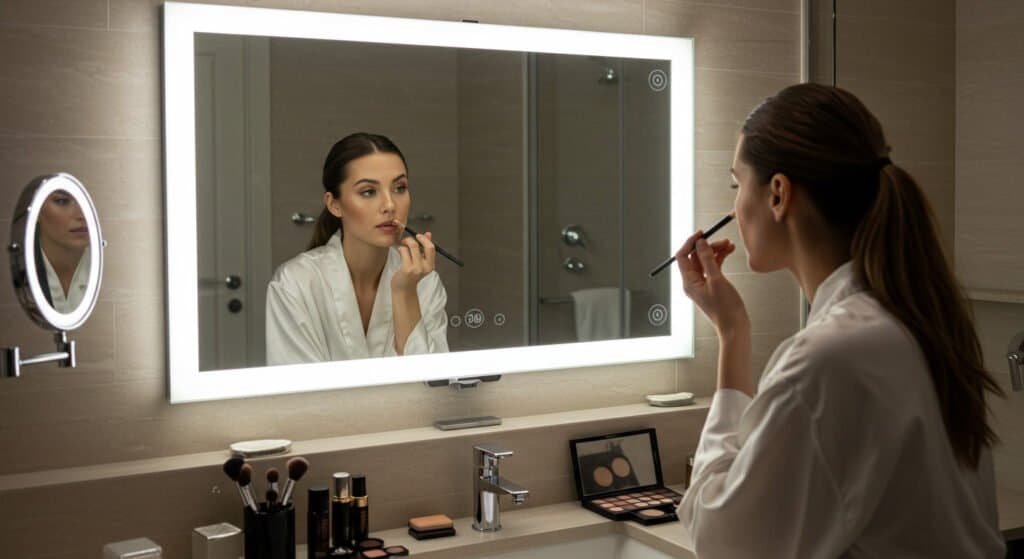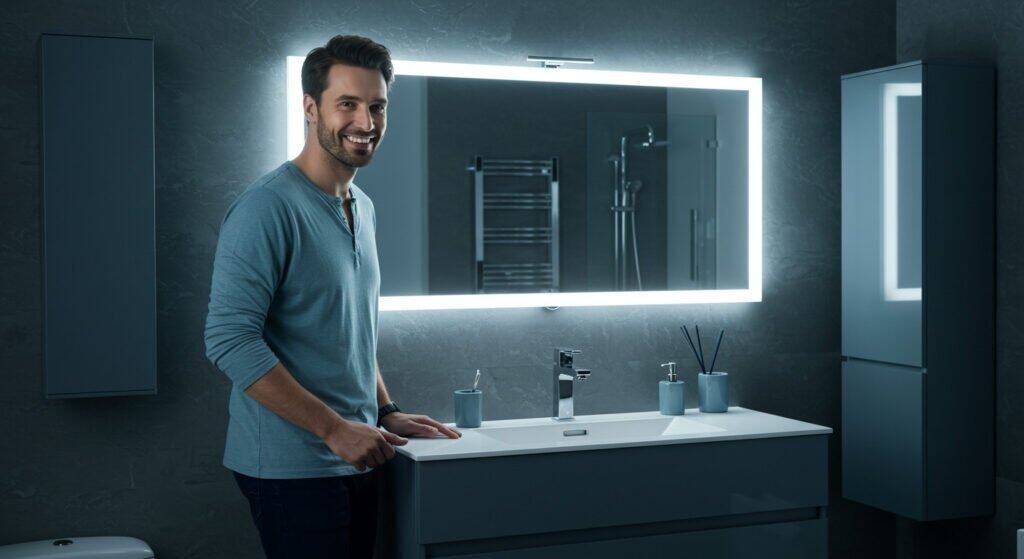Ever wondered what are mirrors? More than just a reflection, it’s a fascinating blend of science and everyday use.
A mirror is an object with a reflective surface, typically made of glass coated with a metallic layer. It reflects light to produce an image. Understanding mirrors involves exploring their types, how they’re made, and their many applications. This guide will cover everything you need to know!
Mirrors might seem simple, but there’s a lot to learn about them. Let’s dive into the reflective world and discover more!

What Types of Mirrors Exist?
Did you know there are all different types of mirrors, each with unique properties? Let’s talk about the different types of mirrors
Mirrors are mainly categorized as plane, convex, and concave. Plane mirrors offer accurate reflections, convex mirrors widen the field of view, and concave mirrors magnify images. Each type serves different purposes.
Mirrors can be used for more than just looking at yourself in the bathroom. There are different types of mirrors with different purposes. Understanding the types of mirrors is important if you’re going to choose a mirror for a specific application.
For example, an optical mirror used in telescopes needs to be extremely precise, while medieval mirrors were often made of polished metal, offering a far different reflection than today’s glass mirror. Today, we even have interactive mirror technologies that blend reflections with digital information. And very early on, people discovered that polished metal could provide a reflection. Then, you have obsidian mirrors, which are actually made from volcanic glass. Knowing this information about different types of mirrors helps you appreciate their different roles.
| Mirror Type | Characteristics | Common Uses |
|---|---|---|
| Plane Mirror | Accurate reflection, limited field of view | Home use, clothing stores, barber shops |
| Convex Mirror | Wide field of view, slight image distortion | Road turns, security in stores, car rearview mirrors |
| Concave Mirror | Magnifies images, focuses light | Makeup mirrors, solar cookers, telescopes |
| Optical Mirror | High precision reflection | Telescopes, lasers, scientific instruments |
How are Mirrors Made?
You think a mirror is a simple object that needs no further explanation or details. Who on earth would want to read about how mirrors are made? It’s interesting. Mirrors are a simple thing, but they’re a complex project. Do you want a peek behind the curtain?
Mirror manufacturing involves glass cutting, cleaning, coating (usually with silver or aluminum), and applying a protective layer. This process transforms ordinary glass into a reflective surface.
Creating a mirror requires precision and care. The glass mirror starts as a sheet of high-quality glass, carefully cut to size. It then undergoes rigorous cleaning to remove any imperfections.
With silver backing, the glass can still distort, but it’s better than aluminum. The magic happens when a thin layer of reflective material, often silver or aluminum, is applied to the back through a process like sputtering. Finally, a protective coating shields the reflective layer from damage and corrosion. This multi-step process ensures the longevity and clarity of the mirror. Hopefully, you can see how each part of the mirror serves a specific purpose. All of these steps, frankly, express how much science and/or craftsmanship go into creating this reflective surface many of us take for granted.

How Do Mirrors Work?
Have you ever stopped to consider how mirrors actually work to create an image?
Mirrors work by reflecting light. When light rays hit the reflective surface, they bounce back at an equal angle, creating an image that our eyes perceive. The smoother the surface, the clearer the reflection.
The way a mirror works can be explained by reflection physics examples, as light travels in waves, and when those waves strike a smooth, reflective surface, like the coating on the back of a mirror, they bounce back in an organized way. This is different from what happens when light hits a rough surface, where the light scatters in many directions.
The physics behind this are governed by the law of reflection, which states that the angle of incidence (the angle at which light hits the mirror) is equal to the angle of reflection (the angle at which light bounces back). This creates the image you see. If the surface is perfectly smooth, the reflection is clear and accurate, but imperfections on the surface can distort the image.
What are Mirrors Used For?
In the next few paragraphs, we’ll explore other uses for mirrors.
Mirrors are used in a wide range of applications, from personal grooming and home decor to scientific instruments and automotive safety. Their ability to reflect light makes them incredibly versatile.
Mirrors serve purposes beyond mere vanity. Bathroom vanity mirrors are essential for grooming. Modern lighted mirrors for bathrooms add function and beauty to the room. In telescopes and lasers, mirrors are critical. In automobiles, rearview mirrors help keep us safe.
Mirrors also play a role in art and architecture, creating illusions of space and depth. The diverse applications of mirrors highlight their importance in both practical and creative fields. For example, my company specializes in led mirror, especially the bathroom light mirror, lighted vanity mirror, lighted makeup mirror and bathroom mirror. We are focusing on providing practical and beautiful modern bathroom mirror.

10 Types of Mirrors
Mirrors also come in many forms beyond the typical bathroom vanity mirror. Here are ten different types of mirrors.
From plane and convex to two-way and dental mirrors, each type has a unique application. Here are ten examples showcasing their diversity.
They include oneway mirrors (used for surveillance), dental mirrors (to examine hard-to-see areas in your mouth), Fresnel mirrors (used in lighthouses), parabolic mirrors (used with solar ovens), spherical mirrors (used in car headlights), and so on.
Each of these types of mirrors is meant for different uses. The characteristics of each mirror are tailored to make it work best for its specific purpose. Even the LED mirror in your bathroom is a specific kind of mirror designed to provide optimal lighting for grooming. So, when we talk about mirrors, it’s important to realize we are talking about all these different kinds of surfaces that reflect.
What is a Plane Mirror?
What makes a plane mirror different from those other types? Let’s define it specifically
A plane mirror is a flat, reflective surface that produces an upright and laterally inverted (left-right reversed) image of the same size as the object. It’s the most common type of mirror used in homes.
This is the type you`re most accustomed to seeing in homes, stores and schools. Essentially, it`s a flat piece of glass that reflects an image that is nearly the same size and shape as the object in front of it. That’s why you can use it to check yourself out or to line things up.
However, there is one little tricky thing about the image in a plane mirror. It`s laterally inverted which is a fancy way of saying your left side appears as your right side in the mirror and vice-versa. The next time you’re looking in the rectangular mirror in the bathroom, have a look at that. It will make you smile.

What is a Concave Mirror?
Concave mirrors have unique properties. Let’s explore what makes them special.
A concave mirror is a curved mirror that bulges inward. It can produce magnified images when an object is placed close to it, or real, inverted images when the object is farther away.
A concave mirror, unlike that flat mirror, curves inward like the inside of a spoon. This curve causes incoming parallel light rays to converge at a single point known as the focal point. Depending on the distance between the object and the mirror, the image formed can either be magnified and upright (when the object is close), or real, inverted, and possibly smaller (when the object is further away).
This unique property makes concave mirrors ideal for applications such as makeup mirrors where magnification is desired and in telescopes where they are used to collect and focus light from distant objects. You won’t find them as often in everyday settings as plane mirrors, but their magnifying and focusing capabilities make them invaluable in certain specialized applications.
How Do Mirrors Work Physics?
Let’s dip into the physics just ever so slightly here. How do mirrors create reflections? What’s the scientific explanation of what goes on?
In physics, mirrors work based on the principle of reflection. Light rays bounce off the smooth surface of the mirror at an angle equal to the angle at which they hit it, forming an image.
The reflection physics examples can be illustrated through the use of light rays. What are mirrors in physics? Mirrors are perfectly smooth surfaces that reflect the vast majority of light that hits them. The incoming light ray (incident ray) strikes the mirror, and the reflected ray bounces off.
The angle of incidence (the angle between the incident ray and the normal, an imaginary line perpendicular to the surface) equals the angle of reflection (the angle between the reflected ray and the normal). This rule applies to all mirrors, whether they are plane mirrors, concave mirrors, or convex mirrors. The smoothness of the surface is essential because it causes the light rays to bounce off the mirror uniformly, creating a clear, undistorted image.

Why Do Mirrors Reflect Backwards?
Mirrors don’t actually reverse left and right; they reverse front to back. What appears as a left-right reversal is simply a result of how we perceive ourselves in relation to the mirror.
This is a misconception. It seems like mirrors reverse left and right because mentally you are turning around to face yourself. If you were to raise your right hand, your reflection would seem to raise its left hand. It’s the image of you that’s doing it, not the actual you.
The mirror is actually reversing depth, not left and right. If you take a piece of transparent paper and write a word on it, then hold the paper up to the mirror, you’ll see the word reversed. The reason is the mirror is turning the front of the paper to the back. Our visual sense of left and right has to do with our body symmetry and that’s what makes it look like the mirror is reversing things left to right.
What are Mirrors in Science?
In science, mirrors are defined as surfaces that reflect a significant portion of incident light. They are essential tools in various scientific instruments, experiments, and technological applications.
What are mirrors in science? In scientific contexts, mirrors aren’t just everyday objects; they are precision instruments that play critical roles in various fields.
In the field of astronomy, huge telescopes use mirrors that are precisely shaped to collect and focus light from stars and galaxies. In the field of physics, mirrors are used in lasers, optical experiments, and a variety of imaging technologies. When a mirror is being used for a scientific purpose, the quality is critical. Often, these mirrors are made with extreme precision to minimize distortions and maximize reflectivity.

What the Heck Exactly Are Mirrors?
Mirrors are fundamentally objects that reflect light in a specific way, creating an image. They are a product of both science and craftsmanship, with applications spanning art, technology, and daily life.
What the heck exactly are mirrors? Mirrors are more than just simple reflective surfaces; they’re a fascinating combination of physics, technology, and artistry. They are used not only to reflect our image, but also to play with light and space, as we can see in room mirror ideas.
From the simplest small bathroom mirror to the most technologically advanced interactive mirror, these things have had a huge impact on art, science, and culture. In my business, we are always trying to integrate technology with design and provide the user with the ultimate experience. For example, our led light mirror vanity, wall mirror with lights, mirrors with black frame, and backlit mirror are all designed to be practical, aesthetically pleasing, and easy to use.
When it comes to meeting the needs of my customers, especially a guy like Tony who is the company’s CEO and chief technical guy, our mirrors need to not only look good but also be of high quality. They need to have special features such as adjustable lighting and anti-fogging. A light up vanity mirror or a vanity mirror with led lights from my company has to be a top-quality, innovative product that makes his life better each and every day.
Conclusion
Mirrors are versatile tools with a rich history and many applications. If you know about the different types of mirrors, how they work, and what they do, you can better appreciate their impact on your life (and in the world of science).
From my perspective, as someone who works with mirrors every day, I see how they can enhance the design and functionality of a space. A well-placed mirror can transform a room, and the addition of LED lighting can make a mirror an even more useful and attractive feature. Whether it’s a bathroom mirror or a lighted vanity mirrors for bathroom, the right mirror can make a big difference.
- Clik here to know What Is Copper Free Mirror?
- If you donot know how too choose the right bathroom height click here.
- Know more about LED bathroom mirror Problems
- Clik here to know why Touch Sensor Mirror Not Working
- Clik here to know What Are Standard Vanity Mirror Sizes?
- Clik here to know Why Are Mirrors So Expensive?
- Clik here to know Do LED Mirrors Need Electricity?
- Clik here to know Is a Lighted Mirror Enough Light for a Bathroom?
- Find out 10 Common LED Bathroom Mirror Problems Click Here



